 |
| |
MI6 recently caught up with sound editor Colin Miller
to talk about his work on six consecutive James Bond
films in the '70s and '80s...
|
|
Colin Miller Interview
2nd March 2009
MI6 recently caught up with sound editor Colin Miller to talk
about his work on six consecutive James Bond films, from "The
Spy Who Loved Me" to "The Living Daylights"...
How did you get started in the film industry and what lead
you down the path of a sound recordist?
I joined a company called Pearl
and Dean – who used to
make cinema commercials – as a runner in the cutting rooms
and animation department of Pearl and Dean. I was there for three
years and went away on holiday and came back to be told that
the entire editorial department had been fired due to internal
policy. Now, it wasn’t just the editorial department, it
was a few other departments as well. There was a commercial company
based in Shepperton studios who were looking for an assistant
editor for a month.
Of course I grabbed that: I went out to Shepperton studios and
began working at the company called Anglo-Scottish for this month’s
holiday-relief and stayed there for three years and got to meet
various people who were working on feature films. One day I got
a call from a feature film editor saying that he was just about
to start at film and was
looking for an assistant and had been given my name. I took
the job as an assistance editor on "The Valiant" and
here I am today.
|
How did you end up working on your first James Bond film,
The Spy Who Loved Me?
I’d been working on a number of films with a sound editor by the name
of Derek Holding – he was a dialogue editor. We’d just finished
a film and Derek went off to join "The Spy Who Loved Me" as a dialogue
editor. When they needed another sound editor Derek was kind enough to put
my name forward. I went for the interview and got the job. I came a little
bit later in the process and quite a bit of the work was already done. So,
hence there is not credit for me at the end of the film, but I was on it for
a while.
For your work on "The Spy Who Loved
Me" – can
you describe one of the sequences that you were involved
with and what exactly your job entailed?
One of the scenes takes place in the desert, when Bond is in the van and trying
to escape but is caught up by Jaws. It was the trip across the desert. That
sequence was shot without any sound whatsoever. Now I had done another movie
involving a rather ancient vehicle. So, Alan Sones used my recording for the
van. It was then my job to apply the sound effects around it. So basically,
he did all the mechanical work and it was me who applied all the smashing of
things by Jaws. |
|
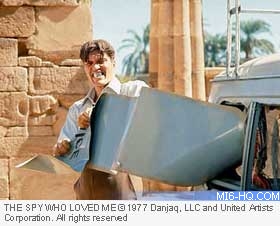
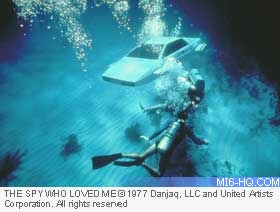
|
Another example is the Lotus
Esprit underwater – dreaming
up sound effects for things like the motors and the steering
or making the frog-men noises sound really genuine. A lot of
editing took place to make sure the timing was all correct. There’s
always the famous chase between the girl in the helicopter and
the Lotus Esprit– that was great fun to
do. As luck would have it, they did have a sound unit covering
a lot of the action. So, a lot of the helicopter stuff that was
shot was used. It was a matter of taking the various elements
and synchronizing those shots. Of course there was the shooting
and gunning of the Lotus and the eventual destruction of the
helicopter.
How long would an average sequence take you – depending
on the complexity?
Some sequences are
quite short while others are perhaps longer cuts. So, you might
spend, on a two minute sequence, 4 or 5 days depending on the
complexity of what you had to do. Because, you see, so many of
the Bond movies have multiple units that intercut and what have
you, and some of the 3rd or 4th units didn’t have sound.
So we have to find that sound and ease the joins into areas that
did have sound. So, this is all part of the creativity.
How did you end up working on the next Bond picture, "Moonraker"?
Well,
a team had been created on "The Spy Who Loved Me" and
it was the same team that was brought back again.
Did you move to France to work with the rest of the production
there?
No, what happened was that the shooting was all being done
in the studio in Paris. The editors were over there but Alan
Sones and myself were based in Pinewood studios. The editors
would cut sequences in France and send them to us. We would then
do our work and do a small dub on those sequences. We would then
do day-trips to Paris with our dubbed sequences, take them to
the editors so that they could continue their work. So, we were
to and from Paris on day trips, during the final shooting process.
|
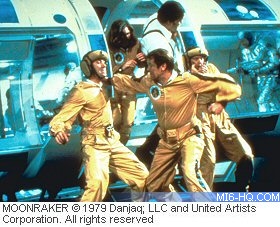
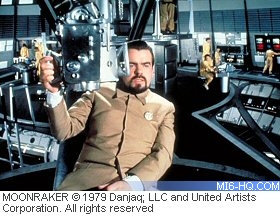
|
|
"Moonraker" is one of the slightly more abstract
Bond films, being in space and other slightly different
environments. Can you tell us how you went about creating
the sound for these different environments?
Well, the thing about "Moonraker" is that it was a huge challenge
in as much as you say: there were just so many changes of location. For a lot
of the effects, in those days there was a very good library that we were free
to draw upon. So we could look at a sequence – and in most cases we had
access to a large collection of effect from previous Bonds. As you probably know,
there is quite a bit of repetition in the Bond films, they always had their favourites.
But any new sequences or scenarios we’d then have to record ourselves or
we would go to the sound library, bring it back and apply it to a sequence.
Brazil was a particular challenge because of the shooting
of the Mardi Gras. Now they did have a sound unit there,
as it was all part of the main unit, so they did cover
a lot of the carnival. We had this material to draw from.
The chase through the Brazilian river was partly library
sound effects and partially sound that was shot during
the sequence. Then we added all the funny gadgetry noises
that went with it. |
When it came to the space station – now
that was our particular challenge. The huge great mission control
was absolutely great
because we had to create a lot of the technical dialogue. There
was a NASA technical advisor on the film but he was actually
able to give us the exact technical details, but in some cases
we had to polish it up to make it a little more "filmic".
For instance, the helpers that were in the space complex, they
needed a name for them – so I came up with an "astro-technician",
and these are the kinds of things that become part of our creativity.
It was very exciting finding the proper sound effects for this
great rocket that is launched into space and then we had to create
all the various sound effects for the space station itself. But
the biggest challenge here was the big battle in space – because
as we’re all aware there is no sound in space. Of course,
this is no good for a Bond picture. Stanley Kubrick pulls it
off very well in "2001: A Space Odyssey", but of
course that is his style of filmmaking.
|
There were various guns that were used – the
pistols, the riffles and the cannons. Now nobody knows
what one of these sounds like so we had to put our thinking
caps on. I suggested we needed something like a synthesizer,
so we went to the office and they found this famous record
producer who had a synthesizer. So, we went to his recording
studio and I think it was CTS studios in Wembley. Before
this we had brought the guy down to our studio and we showed
him our sequence and these short stabs of light from these
pistols and riffles and cannons and we said "this
is what we have to come up with." So he started to
play around with the keyboard until we found sounds we
liked for each gun. We recorded a collection on individual
sounds, about 50 of each, all slightly different lengths.
Now remember that each shot had to be cut and assembled
individually and if you look closely at the film you’ll
see this sequence has a lot of short, sharp shots and so
this meant an awful lot of work. Still, at the end of the
day, it worked very well.
Can you tell us about the sound effects
and atmospheric sounds used on the space station?
We just had to use our imagination, coupled with some technical excellences.
We took our own head there and experimented with things. |
|
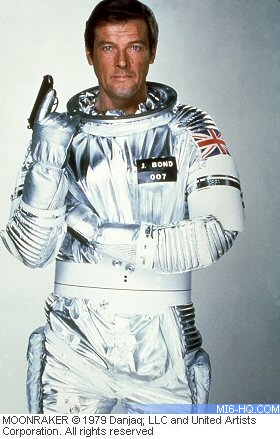
|
As you know the space station is very
big and very active and to find the right kinds of sound effects
for the environment we drew on NASA material that was made available
to us – in terms of background noises. From there, we built
our own atmosphere on top of those. So we created a bed of natural
sound and added our effects on top of that.
How did the "Close Encounters of the Third Kind" motif
end up in the final cut?
That was done through the office. They
negotiated with Spielberg’s
company for the use of that and eventually they got to use it.
It was such a great trick of the time and everybody thought, "well
if we can pull this off it would be great".
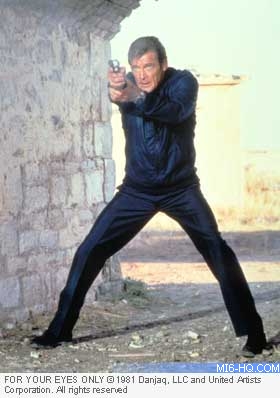 |
|
In "For
Your Eyes Only", a more simple approach
to filmmaking is taken. How did you reflect this change
in the sound editing?
A lot of things are set within the Bond picture. You are more or less following
a line, just making variations of this line as you go along. That’s the
best way I can describe it. It was more, as you say, a conventional Bond movie,
there was nothing so challenging as "Moonraker". There were just
a few things within it that were challenging.
There was that car chase with the Citroen – that
was great fun to do. A 3rd unit shot the whole sequence,
I think, totally without any sound whatsoever. I then had
to go out with the stunt man one very cold November day,
and we recreated that chase. The thing about that was the
fitted out car sounds totally different to just a 2CV engine
that’s normally in one. By re-recording it with the
stronger engine, we made it much more dramatic and much
more fun. Of course with Carol
Bouquet driving we had screeching
and crunching of gears to apply. It was those kind of things
that made it all so exciting. |
When John Glen moved out of the cutting room
to direct the film – how
did this effect the team that had been put together in the earlier
films?
The team that had been working with
John in the previous films all sort of moved up one place. John
Grover
who had been working with Glen as an associated editor was sort
of elevated up to become the editor under John’s direction.
|
One of the more interesting sequences in the film is the
underwater sequence. Can you talk us through what this
involved?
It was a big challenge trying to get reasonable sound quality of genuine underwater
sounds was a bit of a challenge at that time. But we went along to several
sound effects liberates and even in the studio we were able to create reasonable
sounds for underwater. Once again we were back with our frogmen and underwater
spears. But each of the Bond underwater sequences has a new concept we have
to address.
What do you remember most about your work on "For
Your Eyes Only"?
The thing about it is the creativity itself. I think in "Moonraker" there’s
only about 15% of it was original sound – all the rest was made up. You
were re-recording all the dialogue where for technical reasons the recorded
sound was unusable. Perhaps because of dummy explosions or assistant directors
shouting over actors doing their lines. Or if the actor is doing something
at the time – like firing a gun or simply running. We have to find the
sound effects. All these things are blended together. |
|
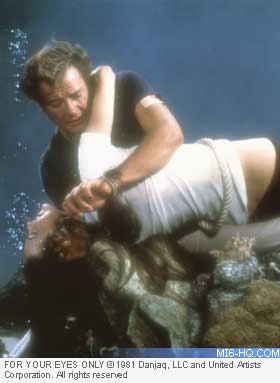
|
As a sound a sound editor, you involved in the final mix of
a film. What is the process and how long does it take?
Yes, as a sound editor, we are totally involved. So, generally
what happens is
that once we’ve prepared our tracks we go into the dubbing theatre with
the dubbing mixer and on our own. Generally on a Bond picture the editor edits
sequences together and sends them to us to mix a rough track over the top. This
way people can say, "we like this sound but we don’t like that one." So
when we go into the final dub a lot of the elements of a sequence are already
known, so it is left to us to "premix" – we take all these
elements, and under our guidance (having known what the editor and director require)
we mix these all together. We do the dialogues first and then we run the dialogue
mix and premix the effects against this. Then we come to the foley sound effects
and the same process occurs.
So, by the time we come to the final dub a lot of the aspects
have already been premixed. At this time we call the director
in and we sit down, work our way through the reel with the comments
coming from the director, editor and sound editor.
Can you talk us through the process of looping?
The looping process
happens whenever the sound from a shoot is unusable – perhaps
you get people talking on location, or perhaps one angle is particularly
noisy or the artists might
be speaking so softly. So when you’re cutting from angle
to angle, the sound levels will jump up and down and what we
have to do is decide if we can save it and smooth it out in the
cutting room, or if it has to be re-recorded again. In the case
of the Bond films it almost always has to be done again as there
are many technical problems associated with it. So, we have to
run the film in the cutting room and write down the text where
the first modulation of the first sentence begins – giving
an in-point and an out-point and we get this all typed up. We
then go into the recording studio with the artists. We run the
sequence and say "this is what we need to do" so
that they appreciate what has to be done. And they re-perform
the line as close as they can under the direction of the director
and the sound editor. Whole sequences are done like this and
its it the dialogue editors job to go through these recordings
saying "we want this
bit from take one and this bit from take two".
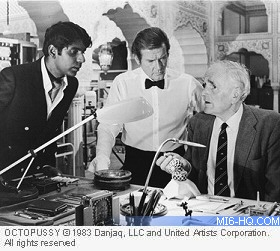
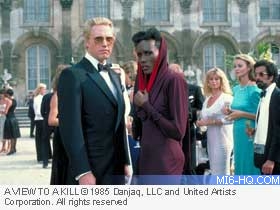
|
|
Can you tell us about dubbing the actors voices and any
stories from the dubbing process?
Well, I was mainly involved with the recording of the sound effects and my colleague
Derek Holding was responsible for the recording of the principal artists. I have
been to many dubbing sessions myself, but not on the Bonds. "Q",
bless him, never got into post sync and because he was such an aged gentleman
by that point, he never knew what it was all about. But, bless him he did try.
Roger, of course, only has one way of doing – and that is Roger’s
way. So if there’s something wrong with the sequence or he sees something
behind him he’d just ask to run the sequence again. Grace
Jones was interesting,
but a little bit feisty: "what are we doing?", "can’t
we use the original here?", "do I really have to do it?" But
that just was Grace Jones.
Can you talk us through creating an atmosphere for the
underground mine in "A
View to a Kill"?
That was nearly 100% replacement as during nearly all those scenes. The director,
or assistant director, would be shouting through a megaphone, directing all
the action. The other reason being that, because it was shot on the 007 Stage – which
is not designed for shooting sound – therefore the acoustics were terrible
and everything had to be replaced in that mine sequence. |
Particularly things like the miniature railway. Because so
many of the scenes were covered by about 5 cameras, the sound
department
couldn’t get in close – so was like a general sound.
But as you see in the final cut there’s lots of changes
of angle and close ups. So I had to go in at the end of the day’s
shooting with a sound recordist and having seen the shots that
had been cut together, run the train just in sound form to cover
the new shots for the picture.
|
How did you record the sounds for the
air-ship that featured in "A View To A Kill"?
That was one of my best days ever! I was given an Air-Ship
500 for a day to play with. So we went to RAF Cardington,
which used to have airships just before
and after the war.
What we did was to pull two pilots into
the cutting room and ran the sequence for them, explaining
what we wanted to do. A few days
later, my assistants, my sound recordist and I went to Cardington where we
explained what we’d like to do first – but the problem we had here
was that we couldn’t use Radio Mics as they would be picked up on the
recording.
So what would happen was that we’d have the air-ships
hovering above us at about 100ft and talk on the radio
to the pilot. I would send them off and tell them that
I would direct them by waving my arms around. So, I looked
like a manic air traffic policeman. So they’d come
at us like a man machine and I’d suddenly whirl my
arms around to indicate that this was the part that they
gun the engines and they’d turn around us, or come
up and stop. |
|
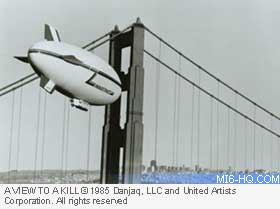
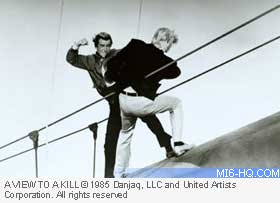
|
Having captured all the external audio they’d come down,
pick us up and then we’d do exactly the same stuff, recording
from inside the cockpit. It was a wonderful noise. If I remember
rightly, it was a pair of Porsche engines and it made the most
wonderful noise. From there, it was my job to go back to the
cutting room and make it all work. A memorable day out – one
of many on the Bond movies.
With the introduction of a new Bond in "The
Living Daylights",
was there a new sound also?
No! The only thing that changed was
Bond. There was a repeat of the generic noises we’d heard
before. The only thing different was the scenarios.
Of all the films you’ve worked on to
date, of which are you the most proud?
Of the Bonds, I’d have to say "Moonraker"!
I was not the supervising sound editor, but I must say that I
was very pleased with my work on the film "The Adventures
of Baron Munchaussen" – I was the dialogue editor
on that. Once again, that was a hugely challenging movie.
Many thanks to Colin Miller.